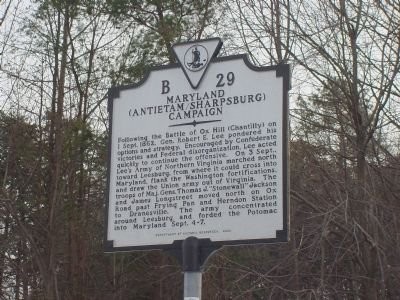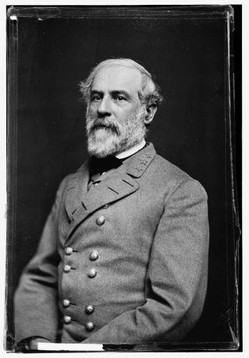Historical Marker: Start of Lee's Antietam/Sharpsburg Campaign
Introduction
Text-to-speech Audio
Images
This is the historical marker where Lee began his journey towards Maryland after his victory at Ox Hill. It contains a brief summary of the events surrounding the battle and what followed afterwards.

The main sign for the battlefield which contains a lot of markers and information about the battle. The marker for the Maryland Campaign can be found in the battlefield by the North entrance.

Confederate General Robert E. Lee who lead his Army of Northern Virginia to victory at Manassas and Ox Hill and invaded Maryland.

Backstory and Context
Text-to-speech Audio
The Confederate victories at both the Second Battle of Manassas and the Battle of Ox Hill provided Lee and his Army of Northern Virginia with the perfect chance to end the war. Lee knew he could secure Southern independence if he was able to convince Northerners that they could not won. He nearly achieved that goal after these battles. Soldiers in the Union Army following those defeats were almost completely demoralized and hardly had any hope for their cause. In order to solidify this state of mind and completely put an end to the war, Lee would need to strike before the Union could reorganize, he had to invade the North.
The day after the Confederate victory at Ox Hill, Lee lead his army North and crossed the Potomac River at Leesburg. Confederate movement forced immediate reaction by the Union, Lincoln was forced to put General George McClellan in charge of the Union Army and to immediately respond to Lee’s movements. The three weeks following Lee’s invasion contained multiple conflicts between Confederate and Union garrisons and what would be known as the bloodiest battle in the Civil War. The fighting at Antietam lasted two days and is known for being the bloodiest and most vicious battle of the war. While there were bright spots and failures on either side, the Maryland Campaign was a failure for Lee and sparked confidence within the Union.
The Maryland Campaign proved to be a turning point in the Civil War. After winning most of the battles in the East during the first half of the war, the Confederacy was repelled. For the Union, they had finally made a strong statement against the Confederacy and by doing so increased the confidence of their people and their soldiers that they could win the war and reunite the Union. After the failure of the Maryland Campaign, Lee and the Army of Northern Virginia would not cross into Northern territory again until his march towards Gettysburg which would also end in a Confederate retreat.
Sources
Hartwig, Scott. "The Maryland Campaign of 1862." American Battlefield Trust. Accessed June 26, 2018. https://www.battlefields.org/learn/articles/maryland-campaign-1862.
Prats, J.J. "Maryland (Antietam/Sharpsburg) Campaign." The Historical Marker Database. February 17, 2006. Accessed June 26, 2018. https://www.hmdb.org/marker.asp?Marker=111.
Prats, J.J. "Battle of Ox Hill (Chantilly)." The Historical Marker Database. February 19, 2006. Accessed June 26, 2018. https://www.hmdb.org/Marker.asp?Marker=115.
